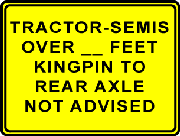45' Buses with Bike Racks
Definitions
45' Bus: On this web page, a 45' bus refers to a bus that is longer than 40 feet but not more than 45 feet.
Bus: CVC Section 233 defines "bus" as: "(a) …any vehicle… …designed, used, or maintained for carrying more than 15 persons including the driver." Or, "(b) A vehicle designed, used, or maintained for carrying more than 10 persons, including the driver, which is used to transport persons for compensation or profit, or is used by any nonprofit organization or group..." Tour buses are also commonly referred to as "coaches," "motorcoaches," and "motor carriers of passengers." This web page deals with buses operating as "passenger transportation vehicles" as defined by CVC 464.
Background
The basic California length law for vehicles is 40 feet unless specifically exempted. The law exempts buses up to 45 feet, but only on those State routes approved by the State, and those local roads approved by the appropriate local government.
In recent years, many local governments have purchased transit buses over 40 feet to increase rider capacity. Bike racks on these 45' buses could cause the length to exceed the 45-foot limit.
State law now exempts bike racks from the length measurement provided that certain criteria are met. (More information under "Legal History")
Routes
LEGAL ROUTES:
Access Routes:
45' buses may travel on virtually every State route EXCEPT those signed with a 30-foot kingpin-to-rear-axle (KPRA) advisory sign. This sign advises trucks with a KPRA of more than 30 feet not to use the route. There are also KPRA advisories signs with 32, 34, 36, and 38 feet. These advisories that are 32 feet and higher ALLOW 45' buses to use the routes. See the advisory sign below.
Advisory Route indicates KPRA length advised.

In case the signs are not posted as intended, it is recommended that drivers also use the maps as described below.
On-Line Map:
By district. Green routes allow 45' buses, and red routes prohibit them.
Stopping for Services:
45' motorhomes may exit the designated route for fuel, food, and lodging provided the access is safe, and provided the service is within one road mile of an "identified" exit. The exit must be identified to show that the service route has been evaluated and approved by State and local engineers. Currently, the only identification system for service exits is a "Service Access" sign, which is an "S" on the back of a truck, as illustrated below. These signs were intended for large trucks, and are located primarily on the interstates.
California Sign Code: G66-55 (CA)

For more information on service access, see the web page Service Access Routes.
City and County Access Roads:
Caltrans has jurisdiction over State routes only. 45' buses are allowed on certain State routes, but not necessarily on local roads. Cities and counties have jurisdiction over local roads. Transit buses should have routes already assigned to them. To inquire about bus access on local roads, contact the appropriate city or county transit department.
Changing Route Classifications:
To request that a road be opened up to 45' buses, follow these instructions:
State routes: Caltrans has already analyzed State routes for their ability to accommodate 45-foot buses, which is the worst case bus that is over 40 feet. However, highway improvement projects that change the geometrics may justify a new evaluation. To inquire about a possible new access route, contact Caltrans Headquarters at (916) 654-5741 for referral to the appropriate Caltrans district staff.
City and county roads: To request a city or county road evaluation for 45' bus access, contact the appropriate city or county public works department. If the city or county road intersects a State highway, Caltrans will also need to evaluate the exit and entrance ramps.
Legal History
Vehicle Length: The basic vehicle length limit in California is stated in the CVC Section 35400(a): "A vehicle may not exceed a length of 40 feet."
Federal Law: In 1991, the federal Intermodal Surface Transportation Efficiency Act (ISTEA) required states to allow buses up to 45 feet long on National Network (NN) highways, which are comprised of primarily interstates. ISTEA allowed states to determine which routes off the NN that 45' buses may use to pick up or deliver passengers.
State Law (Bus Length): The California law that allows buses up to 45 feet is CVC Section 35400(b)(10)(A).
State Routes: In 1995, at the request of bus companies and bus associations, Caltrans reviewed the viability of allowing 45' buses on routes beyond the NN using an engineering analysis. As a result of the analysis, Caltrans allows 45' bus access to virtually all State routes except the 30-foot KPRA advisory routes, as described above under "Legal Routes."
State Law (Bike Racks): On January 1, 2004, Assembly Bill (AB) 1409 created CVC Section 35400(b)(10)(B). This section allows buses up to 45 feet in length to be equipped with a folding device attached to the front body of the bus that is designed and used exclusively for transporting bicycles. The device may not extend more than 36 inches from the front body, and the handlebars of the bicycle may not extend more than 42 inches from the front body. The total length of the bus, including the bicycle device, may not exceed 48.5 feet. Note: This law has changed. Please see the CVC for the latest update.
Route Review Committee (Bike Racks): The law requires that a Route Review Committee shall review the routes where a public agency proposes to operate a 45-foot bus equipped with a front mounted bicycle rack. The Committee shall include one member from the public agency requesting the routes, a traffic engineer representing the public agency that has jurisdiction over the largest proportional share of routes, and a member representing the bus drivers' labor organization. The Committee shall be selected no more than 30 days after receipt of a local agency's proposal to equip a 45' bus with a front-mounted bicycle rack. For more details, see CVC Section 35400(b)(10)(B).

